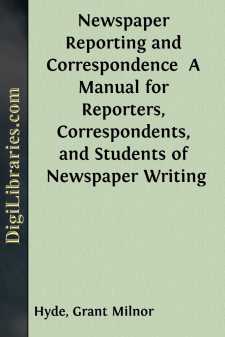Categories
- Antiques & Collectibles 13
- Architecture 36
- Art 48
- Bibles 22
- Biography & Autobiography 813
- Body, Mind & Spirit 142
- Business & Economics 28
- Children's Books 15
- Children's Fiction 12
- Computers 4
- Cooking 94
- Crafts & Hobbies 4
- Drama 346
- Education 46
- Family & Relationships 57
- Fiction 11828
- Games 19
- Gardening 17
- Health & Fitness 34
- History 1377
- House & Home 1
- Humor 147
- Juvenile Fiction 1873
- Juvenile Nonfiction 202
- Language Arts & Disciplines 88
- Law 16
- Literary Collections 686
- Literary Criticism 179
- Mathematics 13
- Medical 41
- Music 40
- Nature 179
- Non-Classifiable 1768
- Performing Arts 7
- Periodicals 1453
- Philosophy 64
- Photography 2
- Poetry 896
- Political Science 203
- Psychology 42
- Reference 154
- Religion 513
- Science 126
- Self-Help 84
- Social Science 81
- Sports & Recreation 34
- Study Aids 3
- Technology & Engineering 59
- Transportation 23
- Travel 463
- True Crime 29
Newspaper Reporting and Correspondence A Manual for Reporters, Correspondents, and Students of Newspaper Writing
Categories:
Description:
Excerpt
INTRODUCTION
The purpose of this book is to instruct the prospective newspaper reporter in the way to write those stories which his future paper will call upon him to write, and to help the young cub reporter and the struggling correspondent past the perils of the copyreader's pencil by telling them how to write clean copy that requires a minimum of editing. It is not concerned with the why of the newspaper business—the editor may attend to that—but with the how of the reporter's work. And an ability to write is believed to be the reporter's chief asset. There is no space in this book to dilate upon newspaper organization, the work of the business office, the writing of advertisements, the principles of editorial writing, or the how and why of newspaper policy and practice, as it is. These things do not concern the reporter during the first few months of his work, and he will learn them from experience when he needs them. Until then, his usefulness depends solely upon his ability to get news and to write it.
There are two phases of the work which every reporter must learn: how to get the news and how to write it. The first he can pick up easily by actual newspaper experience—if nature has endowed him with "a nose for news." The writing of the news he can learn only by hard practice—a year's hard practice on some papers—and it is generally conceded that practice in writing news stories can be secured at home or in the classroom as effectively as practice in writing short stories, plays, business letters, or any other special form of composition. Newspaper experience may aid the reporter in learning how to write his stories, but a newspaper apprenticeship is not absolutely necessary. However, whether he is studying the trade of newspaper writing in his home, in a classroom, or in the city room of a daily paper, he needs positive instruction in the English composition of the newspaper office—rather than haphazard criticism and a deluge of "don'ts." Hence this book is concerned primarily with the writing of the news.
Successful newspaper reporting requires both an ability to write good English and an ability to write good English in the conventional newspaper form. And there is a conventional form for every kind of newspaper story. Many editors of the present day are trying to break away from the conventional form and to evolve a looser and more natural method of writing news stories. The results are often bizarre and sometimes very effective. Certainly originality in expression adds much to the interest of newspaper stories, and many a good piece of news is ruined by a bald, dry recital of facts. Just as the good reporter is always one who can give his yarns a distinctive flavor, great newspaper stories are seldom written under the restriction of rules. But no young reporter can hope to attain success through originality and defiance of rules until he has first mastered the fundamental principles of newspaper writing. He can never expect to write "the story of the year" until he has learned to handle everyday news without burying the gist of his stories—any more than an artist can hope to paint a living portrait until he has learned, with the aid of rules, to draw the face of a plaster block-head. Hence the emphasis upon form and system in this book. And, whatever the form may be, the embodiment must be clear, concise, grammatical English; that is the excuse for the many axioms of simple English grammar that are introduced side by side with the study of the newspaper form.
The author offers this book as the result of personal newspaper experience and of his work as instructor in classes in newspaper writing at the University of Wisconsin. Every item that is offered is the result of an attempt to correct the mistakes that have appeared most often in the papers of students who are trying to do newspaper writing in the classroom. The seemingly disproportionate emphasis upon certain branches of the subject and the constant repetition of certain simple principles are to be excused by the purpose of the book—to be a text-book in the course of study worked out in this school of journalism....


